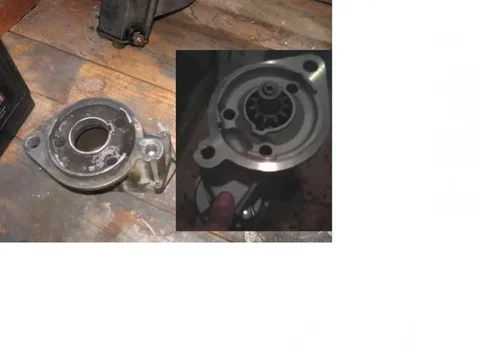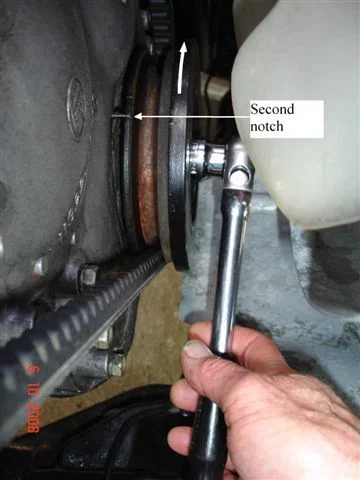Wow. Great photos Albert. If I'd seen those before I doubt I would have developed the idea that your new starter-nose could be wrong. (The noses certainly look identical now but I'd still double-check this with callipers or similar now that you have them out together.)
........After looking at the new starter more carefully, I realized the gromet around the 50 terminal had partially broken off during shipping as I found small bits in the box. I must of missed this when I installed the new starter, duh.........
Lesson learned Eh?
Parts are always at risk of damage during shipping.
If that terminal took a hard knock (and was perhaps pushed-inwards some distance - It is quite possible that there is "hidden internal damage" that is preventing your solenoid from pulling in fully (which would explain the "clack then silence").
I wonder whether you can "make a claim against the shipper" or something like that. (Although normally they would expect an item to be checked thoroughly BEFORE it was ever attempted to be used. - So they may not be prepared to help you now. And if you put yourself in their shoes - You can't blame them.)
If you can't make a claim or get the supplier to accept responsibility for the shipping damage (or aren't prepared to try), then I'd want to look inside the solenoid to see the extent of the damage before trying to fix it. (I'm guessing you're intending to do this anyway.)
I'm not familiar with "JB weld". Here in NZ I would probably use "Araldite" to hold that terminal in its correct position permanently and away-from-metal. (I know that Araldite doesn't conduct electricity.) - But perhaps "JB weld" is a better product? (Of course I have a lathe here so I could perhaps instead turn-up something in nylon if I was in your shoes.)
I don't see the purpose of the "gasket maker". I think I would just "stick the whole terminal to the alloy" and be done with it. Then, if I wanted to take it apart in the future, I would probably just scr#pe away at the Araldite/JB with a sharp scriber or something like that. (But the method you have in mind may well be better than this. - However don't go overboard sacrificing "permanence" for "ease-of-dissassembly".)
So a brief summary of what I was planning:
1. remove the starter and inspect the contacts side
2. compare the nose of the old and new starter
3. use my repair kit to fix the 50 terminal
4. install new battery cable
5. try to hand turn the engine at the crank nut
6. check that the alternator spins freely without the belt attached
7. try to start with the ingition key
Sounds good except I'd ignore the alternator for the time being and concentrate on trying to get your vehicle to start and run. I say this because - provided your battery is big enough and adequately charged - no fault (that I can think of) in your alternator should be able to prevent your cruiser from starting. (I know you have suspicions about your alternator but I suggest tackling just one job at a time.)
And I think it is a good idea to see if your engine is able to rotate freely because a seized engine would explain much of your symptoms. (It is a simple task to check that your engine is free to "turn-over" and it eliminates another possibility - even though it is an unlikely one.)
The only thing extra (to your list) that I suggest is "bench testing" your new starter prior to refitting it (although I'm a bit reluctant to suggest this in light of what happened in your earlier test).
May I suggest holding it in a vice (or have someone kneel on it to hold it firmly - while taking care not to damage terminals and keeping clear of the drive cog that will "jump out and spin" if all goes well) and putting your jumper leads on it? ("Negative" from the battery to the alloy-body of the starter and "Positive" to that big copper terminal.)
Nothing at all should happen as you do this. (No sparks and no sound at all.) But then get a short piece of insulated wire (similar gauge to those connected to your headlights - perhaps even a bit smaller) and
BRIEFLY bridge it between the starter motor's big copper terminal (where your positive crocodile clip is) and the "50 terminal" (touching that black connector shown in the photo will do). As you do this, the starter should come to life (with a "brief healthy spark" as you make that final connection).
As I said, I'm hesitant to make this "bench testing" suggestion in light of the trouble you had when following Ron's advice. But it IS something I think I would do myself. And since there is no load on your starter during this test, it should draw well less than 180A (but I expect it should still draw more than 50A through your jumper leads). Nothing should "melt" and if the crocodile clips are making effective contact, I doubt any "pitting damage" (from excessive sparking) should occur (where the crocodile clips connect) during testing.
....This plan assumes ......and that the 50 terminal somehow caused a short every time I tried to startup the vehicle. .....
I can't see how "the 50 terminal fault" could cause the ends of your
big starter lead to melt when you attempted to turnover your engine the way Ron suggested. So, despite you finding the damage around that terminal, there are still things here that puzzle me Albert. (But damage to "C terminal" could cause that melting - so I hope that terminal didn't get damaged too.)
Whatever you decide to do -- Take your time and take care.
Cheers
Tom

 Now looking at these images again I see the two noses side-by-side do indeed look identical. It is just that Gizmo's is so dirty and it is hard to rotate the noses into alignment inside one's head! So I really don't know what your problem is Albert. If you still have your old nose, perhaps you can do a nose-swap just to prove beyond doubt that the new nose isn't responsible for your problem. I'm as lost as you are here really. (If that remanufactured starter does turn out to both fit and run then I'll certainly add this information to my "B-engine parts interchangeability thread".)
Now looking at these images again I see the two noses side-by-side do indeed look identical. It is just that Gizmo's is so dirty and it is hard to rotate the noses into alignment inside one's head! So I really don't know what your problem is Albert. If you still have your old nose, perhaps you can do a nose-swap just to prove beyond doubt that the new nose isn't responsible for your problem. I'm as lost as you are here really. (If that remanufactured starter does turn out to both fit and run then I'll certainly add this information to my "B-engine parts interchangeability thread".) 

